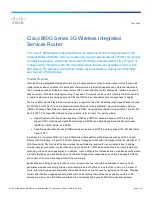
________
1 Introduction
The Wireless High Power and High Gain Multi-Client Bridge/Access Point/ WDS
(wireless distribution system) operates seamlessly in the dual band 2.4/5 GHz
frequency spectrum supporting the 802.11b (2.4GHz, 11Mbps) and the newer, faster
802.11g (2.4GHz, 54Mbps)/ 802.11a (5GHz, 54Mbps) wireless standards.
High output power and high sensitivity can extend range and coverage to reduce the
roaming between APs to get more stability wireless connection. It also can reduce
the expense of equipment in the same environment.
To protect your wireless connectivity, this device can encrypt all wireless
transmissions through 64/128-bit WEP data encryption and also supports
WPA2/WPA/802.1x for powerful security authentication. The MAC addresses filter
lets you select exactly which stations should have access to your network.
This chapter describes the features & benefits, package contents, applications, and
network configuration.
1.1 Features & Benefits
Features
Benefits
High Speed Data Rate Up to 54Mbps
Capable of handling heavy data payloads
such as MPEG video streaming
High Output Power up to 26 dBm in
11b/g
Excellent output power spreads the operation
distance
IEEE 802.11b/g Compliant
Fully Interoperable with IEEE
802.11b/IEEE802.11g compliant devices
Point-to-point, Point-to-multipoint
Wireless Connectivity
Let users transfer data between two
buildings or multiple buildings
WPA2/WPA/ IEEE 802.1x support
Powerful data security
Hide SSID (AP Mode)
Avoids unallowable users sharing bandwidth,
increases efficiency of the network
DHCP Client/ Server
Simplifies network administration
WDS (Wireless Distributed System)
Make wireless AP and Bridge mode
simultaneously as a wireless repeater
MAC address filtering (AP Mode)
Ensures secure network connection
SNMP/Telnet Remote Configuration
Management
Help administrators to remotely configure or
manage the Access Point easily.
Power-over-Ethernet (IEEE802.3af)
Flexible Access Point locations and cost
savings






































